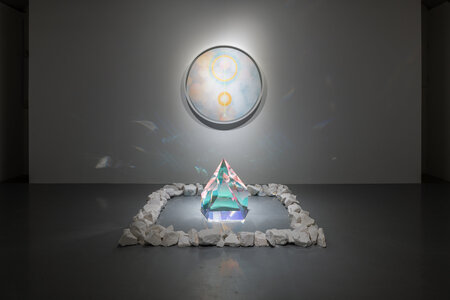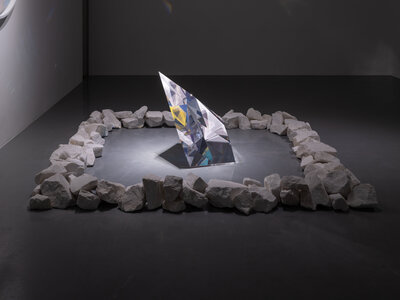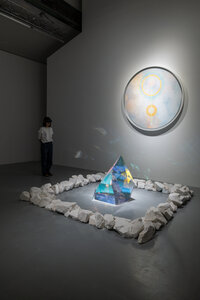Mariko Mori
“Kojiki”
Mariko Mori has been giving shape to an invisible world that surrounds us by conducting her extensive research of archeology to the latest physics and Buddhist somatism. Since her early career in the mid-90s which garnered international acclaim, the artist has extended her artistic inquiries into a more philosophical realm, exploring the possibilities of undefined dimensions of human consciousness. The exhibition titled “Kojiki” features her installation inspired by the Japanese mythic chronicle on the Age of Shito tradition’s Gods, alongside works from her new project premiering in Venice in June.
The radiant acrylic sculpture occupies the center of the main gallery floor, encircled by stones of varying shapes and sizes. Made after field research on iwakura (the sacred rock for god’s descent in ancient animism) found across Japan, Kojiki Installation (2019-2024) embodies Mori’s ongoing reflections since her last solo exhibition with the gallery in 2020. The spatial composition of the work draws inspiration from an ancient ritual site in Okinoshima. The mixed reality experience, rendered possible using a device called “holo-lens”, will immerse the viewer in an additional layered dimension, with Mori herself appearing in a virtual setting. Evoking the early days of her career when she portrayed futuristic characters, the phantasmagorical holographic figure of the artist as a priestess performs a ritual service in front of iwakura utilizing the Three Sacred Treasures (the mirror, the sword, and the crescent jewel).
The large disk-shaped photographic painting, Unity (2023) depicts metaphysical images drawn from the mythic chronicle about the creation of the world, which serves as a central theme of the exhibition. Each of three interconnected circles represents, respectively, the invisible world of Gods, the world of reality, and another undefined world of the human mind as envisioned by Mori. The subtly glittering surface with three-dimensional CG effects, echoing a central structure, creates a prism unifying colors and forms within the space. Referencing the legend of the creation myth of Japan by Izanami and Izanagi, the 180 centimeters tall monument Onogoro Stone (2024) generates a spectrum of colors that vary according to the angle of view, emphasizing the artist's minimalist approach to light and space.
Displayed on the stepped floor is a picture scroll that contains images and visual reflections of a sculpture that symbolizes human 'spirituality’, accompanied by handwritten calligraphy describing Mori’s inner experience of invisible light. The sculpture titled Peace Crystal (2016-2024) will be installed within a pavilion specially designed by the artist for its premier presentation in Venice this year (Palazzo Corner della Ca’ Grande / June-October, 2024). Standing approximately 167.5 centimeters tall, the work models the average human height, and was created following Mori's intuition that the upright walking posture bestowed intelligence and spirituality upon mankind. Peace Crystal will be donated to Ethiopia, the land of origin for mankind on the African continent, with the artist’s vision to permanently install the work inside a cave.
The transcendent vision of light that the viewer experiences through holo-lens is also the destination suggested by Mori’s Buddhist-philosophical pursuit. Dogen (1200-1253) expounded in his Shobogenzo on the concepts of ikka myōshu (single luminous spirit / True Self) and kōmyō (bright buddhist light), stating that "the whole world is one shining thing, and all things, living and dying, are the light emanating from the Self”. *1 The artist honors Dogen’s philosophy into her metaphysical practice of material and figuration, elaborating a visualization of wholeness. Within this exhibition, Mori’s profound exploration of the human consciousness and its spirituality conjures a site reminiscent of a future ritual.
*1: Citation from “Shohogenzo” (1), (4), Kodansha Gakujutsu Bunko, all translation and notes by Fumio Masutani, 2004.










